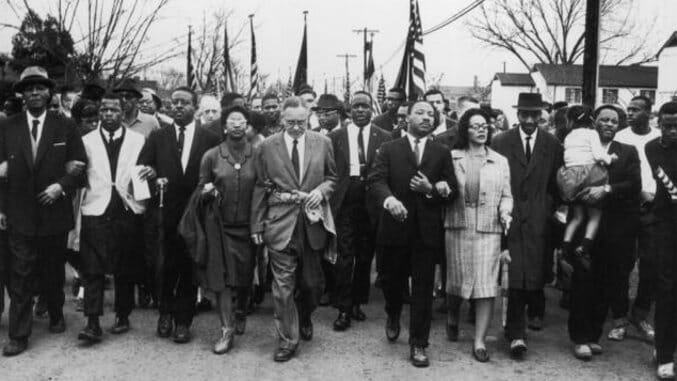And Still I Rise: Black America Since MLK by Henry Louis Gates, Jr. and Kevin M. Burke
Photo by William Lovelace / Stringer
As parents, students and teachers struggle with the current state of the American educational system, there have been a handful of small but significant gestures made over the years in an attempt to correct one of the biggest issues in the history lessons young people receive. A mother recently took to social media to share a page from her child’s newly-published McGraw-Hill Education textbook, wherein the Atlantic Slave Trade was labeled as a “pattern of immigration” and the brutality of slavery described in one caption as an event where “millions of workers” were brought from Africa to “work on agricultural plantations.” The story went viral, and the publishing company is now investigating their “mistake.”
 Last year, free screenings of Ava DuVernay’s film Selma were offered for elementary students across the country. And in 2014, Steve McQueen’s Best Picture winner 12 Years a Slave inspired The National School Boards Association to add the film, along with the original autobiography and a study guide, to high school curriculums. And Still I Rise: Black America Since MLK is one more incredible work that deserves a space, not only in home book collections and university libraries, but in our elementary and high school classrooms, many of which are still starved for a visually compelling and well-rounded dive into Black America as it continues to rise, fall and rise again over the years.
Last year, free screenings of Ava DuVernay’s film Selma were offered for elementary students across the country. And in 2014, Steve McQueen’s Best Picture winner 12 Years a Slave inspired The National School Boards Association to add the film, along with the original autobiography and a study guide, to high school curriculums. And Still I Rise: Black America Since MLK is one more incredible work that deserves a space, not only in home book collections and university libraries, but in our elementary and high school classrooms, many of which are still starved for a visually compelling and well-rounded dive into Black America as it continues to rise, fall and rise again over the years.
The illustrated chronology and companion book to the PBS series of the same name poses a plethora of questions in its introduction, beginning with, “What binds African Americans together?” and ending with, “Given the sheer diversity and divergence…within Black America…is it still even possible to think of forty-two million people as a unified cultural social entity at all?” Henry Louis Gates, Jr. has been attempting and providing various answers to such questions since his seminal work in literary criticism (The Signifying Monkey) and with incredible anthologies (Reading Black, Reading Feminist and Tradition and the Black Atlantic). In every literary exploration, he’s offered up a lesson in intersectional thinking—a lesson sorely missing from much of American curriculum (all the way from elementary school to higher education).
It’s not a critique to say that And Still I Rise is one of the more accessible works of his catalogue. Along with Kevin M. Burke, Director of Research at Harvard University’s Hutchinson Center for African and African American Research, Gates uses hundreds of images—ranging from powerful shots like Malcolm X holding up a newspaper headline reading “Our Freedom Can’t Wait!” to images of the countless race-related protests and riots that have swept this country, including Stanley Forman’s Pulitzer Prize-winning The Soiling of Old Glory (which captures a white teen attacking a black lawyer and activist with the American flag on a pole during the busing crisis—a history lesson which never made it into my elementary education in Boston). But many more photos tell other stories of black history and culture—the movie poster featuring Pam Grier from Foxy Brown, NASA astronaut Ronald E. McNair playing his saxophone on the Challenger space shuttle and Arsenio Hall removing his sunglasses to deliver a late-night monologue are all given equal weight and attention in this collection.
-

-

-

-

-

-

-

-

-

-

-

-

-

-

-

-

-

-

-

-

-

-

-

-

-

-

-

-

-

-

-

-

-

-

-

-

-

-

-

-








































